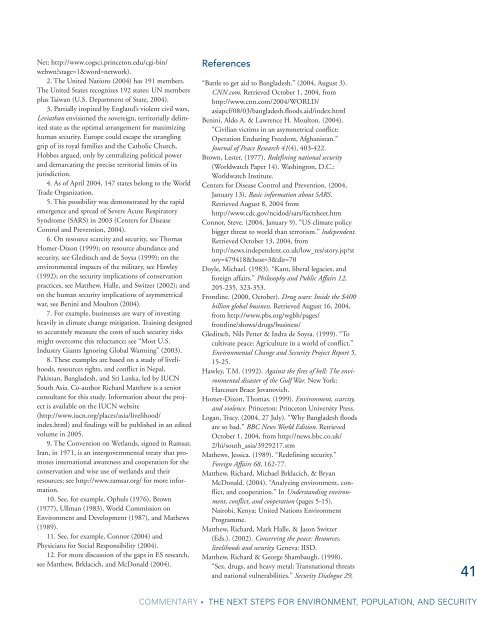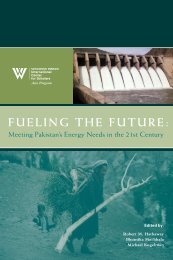Environmental Change and Security Project Report - Woodrow ...
Environmental Change and Security Project Report - Woodrow ...
Environmental Change and Security Project Report - Woodrow ...
Create successful ePaper yourself
Turn your PDF publications into a flip-book with our unique Google optimized e-Paper software.
Net: http://www.cogsci.princeton.edu/cgi-bin/<br />
webwn?stage=1&word=network).<br />
2. The United Nations (2004) has 191 members.<br />
The United States recognizes 192 states: UN members<br />
plus Taiwan (U.S. Department of State, 2004).<br />
3. Partially inspired by Engl<strong>and</strong>’s violent civil wars,<br />
Leviathan envisioned the sovereign, territorially delimited<br />
state as the optimal arrangement for maximizing<br />
human security. Europe could escape the strangling<br />
grip of its royal families <strong>and</strong> the Catholic Church,<br />
Hobbes argued, only by centralizing political power<br />
<strong>and</strong> demarcating the precise territorial limits of its<br />
jurisdiction.<br />
4. As of April 2004, 147 states belong to the World<br />
Trade Organization.<br />
5. This possibility was demonstrated by the rapid<br />
emergence <strong>and</strong> spread of Severe Acute Respiratory<br />
Syndrome (SARS) in 2003 (Centers for Disease<br />
Control <strong>and</strong> Prevention, 2004).<br />
6. On resource scarcity <strong>and</strong> security, see Thomas<br />
Homer-Dixon (1999); on resource abundance <strong>and</strong><br />
security, see Gleditsch <strong>and</strong> de Soysa (1999); on the<br />
environmental impacts of the military, see Hawley<br />
(1992); on the security implications of conservation<br />
practices, see Matthew, Halle, <strong>and</strong> Switzer (2002); <strong>and</strong><br />
on the human security implications of asymmetrical<br />
war, see Benini <strong>and</strong> Moulton (2004).<br />
7. For example, businesses are wary of investing<br />
heavily in climate change mitigation. Training designed<br />
to accurately measure the costs of such security risks<br />
might overcome this reluctance; see “Most U.S.<br />
Industry Giants Ignoring Global Warming” (2003).<br />
8. These examples are based on a study of livelihoods,<br />
resources rights, <strong>and</strong> conflict in Nepal,<br />
Pakistan, Bangladesh, <strong>and</strong> Sri Lanka, led by IUCN<br />
South Asia. Co-author Richard Matthew is a senior<br />
consultant for this study. Information about the project<br />
is available on the IUCN website<br />
(http://www.iucn.org/places/asia/livelihood/<br />
index.html) <strong>and</strong> findings will be published in an edited<br />
volume in 2005.<br />
9. The Convention on Wetl<strong>and</strong>s, signed in Ramsar,<br />
Iran, in 1971, is an intergovernmental treaty that promotes<br />
international awareness <strong>and</strong> cooperation for the<br />
conservation <strong>and</strong> wise use of wetl<strong>and</strong>s <strong>and</strong> their<br />
resources; see http://www.ramsar.org/ for more information.<br />
10. See, for example, Ophuls (1976), Brown<br />
(1977), Ullman (1983), World Commission on<br />
Environment <strong>and</strong> Development (1987), <strong>and</strong> Mathews<br />
(1989).<br />
11. See, for example, Connor (2004) <strong>and</strong><br />
Physicians for Social Responsibility (2004).<br />
12. For more discussion of the gaps in ES research,<br />
see Matthew, Brklacich, <strong>and</strong> McDonald (2004).<br />
References<br />
“Battle to get aid to Bangladesh.” (2004, August 3).<br />
CNN.com. Retrieved October 1, 2004, from<br />
http://www.cnn.com/2004/WORLD/<br />
asiapcf/08/03/bangladesh.floods.aid/index.html<br />
Benini, Aldo A. & Lawrence H. Moulton. (2004).<br />
“Civilian victims in an asymmetrical conflict:<br />
Operation Enduring Freedom, Afghanistan.”<br />
Journal of Peace Research 41(4), 403-422.<br />
Brown, Lester. (1977). Redefining national security<br />
(Worldwatch Paper 14). Washington, D.C.:<br />
Worldwatch Institute.<br />
Centers for Disease Control <strong>and</strong> Prevention. (2004,<br />
January 13). Basic information about SARS.<br />
Retrieved August 8, 2004 from<br />
http://www.cdc.gov/ncidod/sars/factsheet.htm<br />
Connor, Steve. (2004, January 9). “US climate policy<br />
bigger threat to world than terrorism.” lndependent.<br />
Retrieved October 13, 2004, from<br />
http://news.independent.co.uk/low_res/story.jsp?st<br />
ory=479418&host=3&dir=70<br />
Doyle, Michael. (1983). “Kant, liberal legacies, <strong>and</strong><br />
foreign affairs.” Philosophy <strong>and</strong> Public Affairs 12,<br />
205-235, 323-353.<br />
Frontline. (2000, October). Drug wars: Inside the $400<br />
billion global business. Retrieved August 16, 2004,<br />
from http://www.pbs.org/wgbh/pages/<br />
frontline/shows/drugs/business/<br />
Gleditsch, Nils Petter & Indra de Soysa. (1999). “To<br />
cultivate peace: Agriculture in a world of conflict.”<br />
<strong>Environmental</strong> <strong>Change</strong> <strong>and</strong> <strong>Security</strong> <strong>Project</strong> <strong>Report</strong> 5,<br />
15-25.<br />
Hawley, T.M. (1992). Against the fires of hell: The environmental<br />
disaster of the Gulf War. New York:<br />
Harcourt Brace Jovanovich.<br />
Homer-Dixon, Thomas. (1999). Environment, scarcity,<br />
<strong>and</strong> violence. Princeton: Princeton University Press.<br />
Logan, Tracy. (2004, 27 July). “Why Bangladesh floods<br />
are so bad.” BBC News World Edition. Retrieved<br />
October 1, 2004, from http://news.bbc.co.uk/<br />
2/hi/south_asia/3929217.stm<br />
Mathews, Jessica. (1989). “Redefining security.”<br />
Foreign Affairs 68, 162-77.<br />
Matthew, Richard, Michael Brklacich, & Bryan<br />
McDonald. (2004). “Analyzing environment, conflict,<br />
<strong>and</strong> cooperation.” In Underst<strong>and</strong>ing environment,<br />
conflict, <strong>and</strong> cooperation (pages 5-15).<br />
Nairobi, Kenya: United Nations Environment<br />
Programme.<br />
Matthew, Richard, Mark Halle, & Jason Switzer<br />
(Eds.). (2002). Conserving the peace: Resources,<br />
livelihoods <strong>and</strong> security. Geneva: IISD.<br />
Matthew, Richard & George Shambaugh. (1998).<br />
“Sex, drugs, <strong>and</strong> heavy metal: Transnational threats<br />
<strong>and</strong> national vulnerabilities.” <strong>Security</strong> Dialogue 29,<br />
41<br />
COMMENTARY • THE NEXT STEPS FOR ENVIRONMENT, POPULATION, AND SECURITY

















